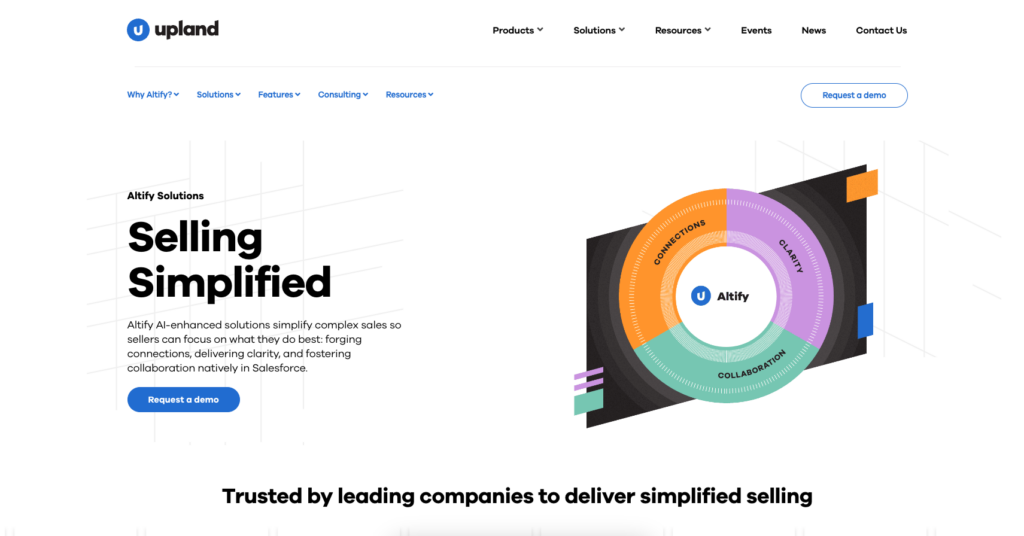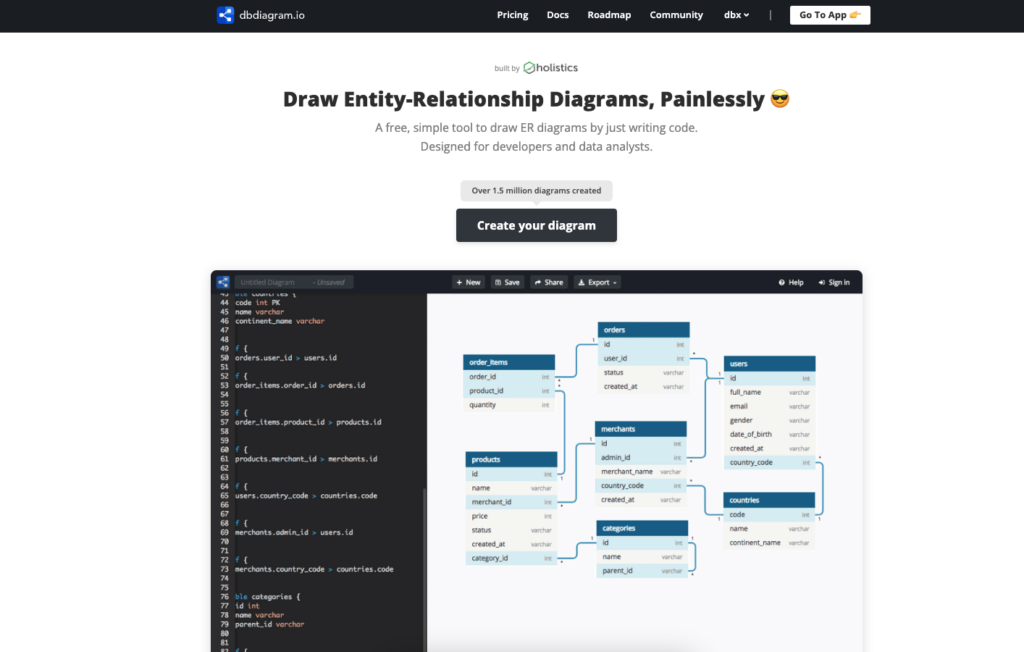You are a sales representative trying to close a major deal with a large corporation. You’ve researched, prepared your pitch, and identified the potential client. However, despite your best efforts, navigating the intricate network of decision-makers within the organization is challenging. This is where a relationship mapping platform becomes a crucial asset for revenue teams.
With Gartner reporting that between 6 and 10 people now participate in the average B2B purchase decision, companies can no longer rely on the strength of one relationship to ensure business decisions go in their favor. It doesn’t work like that anymore. Most executives just aren’t willing to put their names on the line to overrule a buying committee. It’s too risky. To handle this complexity, sellers need the right tools, strategies, and methodologies to understand the people, problems, and relationships that matter within an account.
Let’s consider a practical example to illustrate the concept. Your company is trying to sell a new software solution to a large tech company. You’ve identified Jane, a senior manager in the IT department, as a key contact. Jane likes your product, but she’s not the final decision-maker.
Through relationship mapping, you discover that Jane reports to Bob, the IT Director, who has a close working relationship with Susan, the CFO. Further analysis reveals that Susan is good friends with Alex, the CEO, who has the final say on all major purchases. Additionally, you learn that John, a project manager in the IT department, is an influential voice in tech-related decisions due to his extensive experience and technical expertise.
Armed with this information, you can tailor your approach:
- Build rapport with John by addressing technical details and showcasing the software’s capabilities, gaining his endorsement.
- Engage Jane to gather insights and keep her in the loop as she is your initial contact.
- Prepare a strong business case for Bob that highlights the software’s benefits to the IT department.
- Craft a financial justification for Susan, emphasizing cost savings and ROI, ensuring she sees the value from a financial perspective.
- Present a holistic proposal to Alex, leveraging endorsements from Jane, John, Bob, and Susan, to secure his approval.
By mapping these relationships, you can strategically influence the right people at the right time, significantly increasing your chances of closing the deal.
Understanding the web of relationships within an organization can be a game-changer. Whether you’re in sales, project management, or customer support, knowing who influences whom and how decisions are made can significantly boost your effectiveness. Relationship mapping software tools are designed to provide this insight, offering a visual representation of the connections between individuals within an organization. These tools are essential for building meaningful relationships, driving informed strategies, and winning more business with the help of AI. With the benefits of relationship mapping tools in mind, it’s clear that relationship mapping software is a valuable tool for identifying key stakeholders and building meaningful relationships with them to drive success.
What is Relationship Mapping?
Mapping relationships software tools involve creating a visual representation of the connections between individuals within an organization. These maps can help identify key decision-makers, influencers, and the organization’s overall structure. By leveraging a relationship mapping app or platform, businesses can understand relationships and strategize more effectively.
Relationship mapping tools are designed to automate and simplify this process. They collect data from various sources, such as CRM systems, emails, and social media, to create comprehensive maps that can be easily interpreted and acted upon.
Best Business Relationship Mapping Tools in 2024
1. DemandFarm
DemandFarm stands out as a comprehensive solution for relationship mapping and key account management. DemandFarm’s Org Chart tool integrates seamlessly with major CRM systems like Salesforce, Microsoft Dynamics, Hubspot, Zoho etc., making it easy to gather and visualize data. DemandFarm offers features like:
- Auto-create Relationship Maps / Org Chart: DemandFarm’s AI-powered Relationship Maps allow users to auto-create visual relationship charts that visually represent the structure of the key relationships within your key accounts. By mapping out the entire relationship hierarchy, users can quickly identify key stakeholders, understand their roles, and see how different departments and individuals are connected. This visualization is crucial for strategizing engagements and ensuring that you are communicating with the right people in the right way.
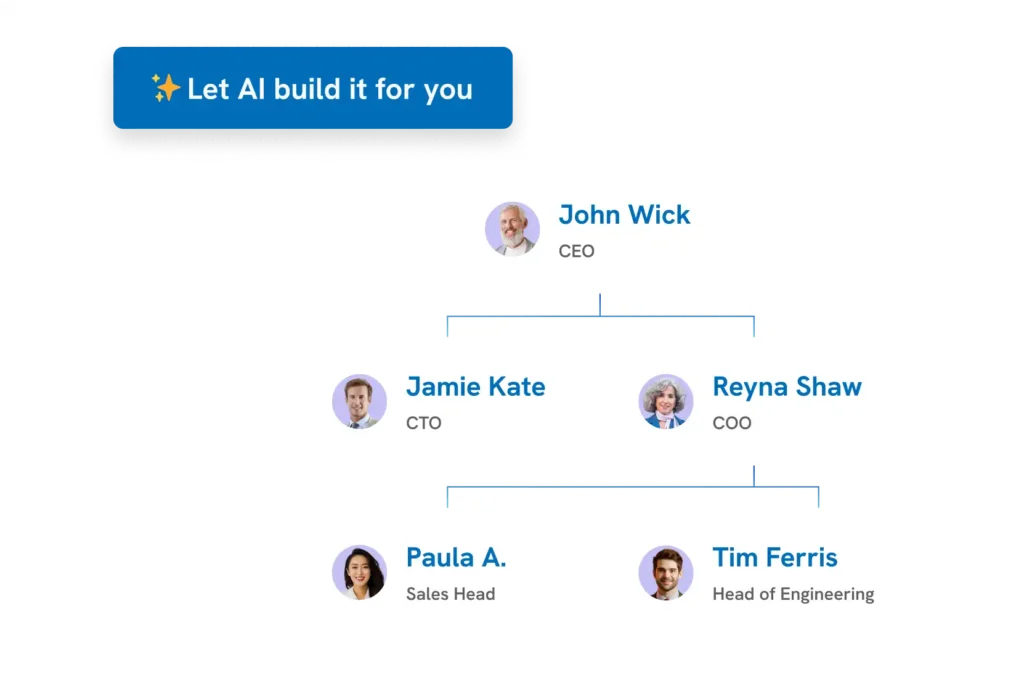
- Relationship Intelligence: DemandFarm goes beyond simple organizational charts by providing in-depth relationship intelligence. This feature gives users insights into the strength and type of relationships between contacts within an organization. For example, it can highlight who the decision-makers are, who the influencers are, and who might act as potential blockers in a deal. At the same time understand their influences, status, power, and level with the buying group.
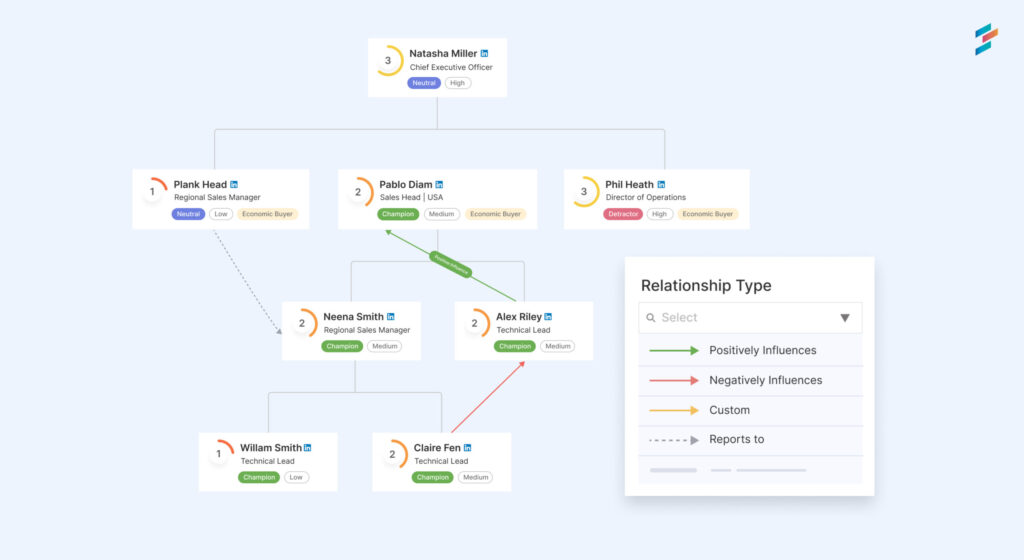
- Engagement Analytics: DemandFarm helps you visualize and analyze stakeholder communication analyze your entire team’s interactions with key account stakeholders and assess the engagement levels. This helps sales leaders and account managers monitor relationship health in their key accounts and spot unknown gaps and risks early for proactive mitigation and fostering stronger client relationships.
- Customizable Views: Flexibility is key with DemandFarm’s customizable views. Users can tailor their relationship maps to focus on specific departments, opportunities, types of relationships, or even individual roles. This customization allows teams to hone in on the most relevant information for their specific objectives, whether it’s targeting a particular division for a sales pitch or understanding the leadership dynamics of a project team.
Learn more about DemandFarm’s relationship mapping product org chart software.
Ready to Understand Your Key Relationships, Decision-Makers, Influencers & Detractors Better?
2. ClickUp
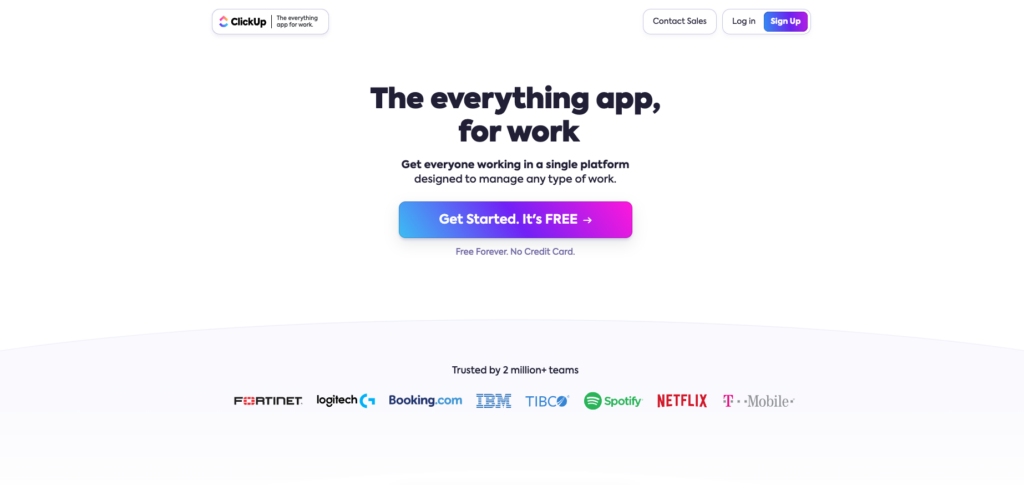
ClickUp is renowned for its versatility as a project management tool, but it also excels in the realm of relationship mapping with its best relationship mapping software features for business development. This multifaceted platform offers a comprehensive set of features designed to help businesses visualize and manage their relationships and workflows effectively. By integrating mind maps, whiteboards, and numerous other tools, ClickUp provides a seamless experience for teams looking to streamline their operations and improve their strategic planning with the best comprehensive guide for relationship mapping tools available. Additionally, ClickUp also offers integration with Salesforce and Quip, making it a top choice for businesses looking to combine their relationship maps with their CRM and sales tasks.
- Mind Maps: ClickUp’s mind maps allow you to draw connections and map out relationships in real time. This feature is perfect for teams that need to visualize complex organizational structures or brainstorm ideas collaboratively. You can create nodes for different individuals or departments and link them to showcase their relationships, influence, and roles within the organization.
- Whiteboards: A drag-and-drop interface for brainstorming and organizing ideas. It offer a user-friendly, drag-and-drop interface that is ideal for brainstorming and organizing ideas. These digital whiteboards can be used to create detailed visual representations of projects, workflows, and relationship maps. You can add sticky notes, draw diagrams, and insert images to create a comprehensive visual plan.
- Integrations: Connects with various tools and platforms, making it easy to consolidate information. Whether you use CRM systems like Salesforce, communication tools like Slack, or file storage services like Google Drive, ClickUp can connect with them all. This integration capability ensures that all your data is synchronized and easily accessible within ClickUp, providing a unified workspace for your team.
3. Prolifiq
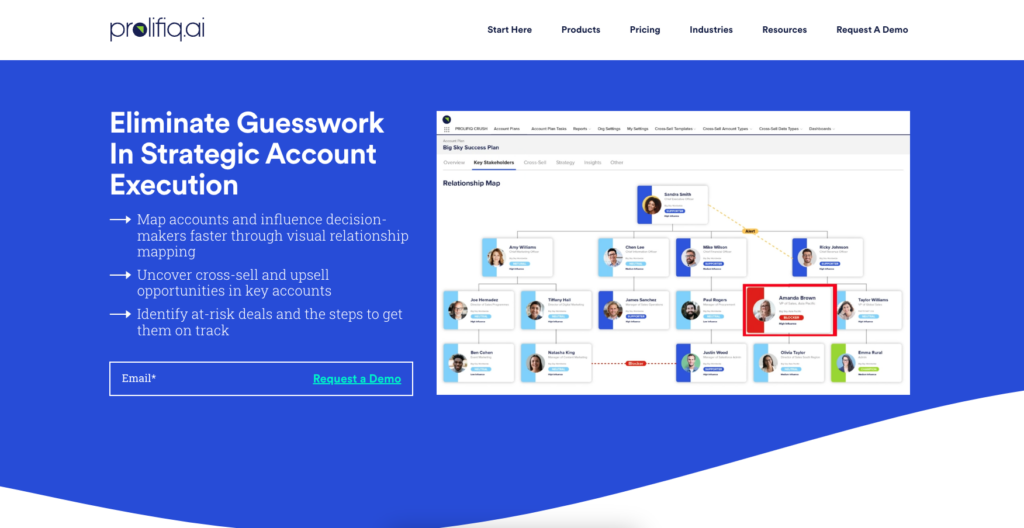
Prolifiq is designed specifically for sales teams, offering robust relationship mapping features that integrate seamlessly with Salesforce. This tool focuses on enhancing the effectiveness of sales strategies through detailed stakeholder management, account planning, and content management.
- Stakeholder Management: Prolifiq allows sales teams to identify key stakeholders within target organizations and prioritize them based on their influence and decision-making power. This helps in focusing efforts on the most critical contacts.
- Account Planning: Prolifiq helps sales teams organize their approach to key accounts, ensuring that all activities are aligned with overall sales objectives. It enables the creation of detailed account plans tailored to each client.
- Content Management: Prolifiq integrates with Salesforce to manage digital content efficiently, ensuring that all sales materials are accessible and up-to-date. This integration streamlines workflows and reduces the time spent searching for information.
Prolifiq’s tools are tailored to enhance sales strategies by providing a clear picture of relationship dynamics within target accounts.
4. Upland Altify
Upland Altify offers a robust relationship mapping solution that integrates seamlessly with Salesforce. This tool not only maps relationships within target organizations but also helps refine and improve sales processes through its comprehensive features.
- Stakeholder Influence: Upland Altify allows you to visualize the influence and purchasing power of contacts within an organization, helping to identify the key decision-makers and influencers.
- Process Improvement: Upland Altify allows you to visualize the influence and purchasing power of contacts within an organization, helping to identify the key decision-makers and influencers.
- Real-Time Collaboration: Upland Altify supports real-time collaboration, allowing sales teams to update and refine relationship maps together, ensuring everyone has the latest information.
5. DBDiagram
For those looking for a more technical and free option, DBDiagram is one of the relationship mapping tools that integrate with SQL databases to visualize data. While it requires some technical knowledge, it offers robust features that make it a valuable asset for users who need detailed and flexible data visualization.
- Data Integration: DBDiagram connects directly with SQL databases, allowing users to visualize data in real-time. This integration ensures that your relationship maps are built on the most current and accurate data.
- Export Options: Users can export their relationship maps as images or PDFs, making it easy to share visualizations with team members or include them in reports and presentations.
- Technical Flexibility: DBDiagram is suitable for users who need to integrate with web frameworks like Ruby on Rails or Django, providing flexibility for developers working within these environments.
6. Creately
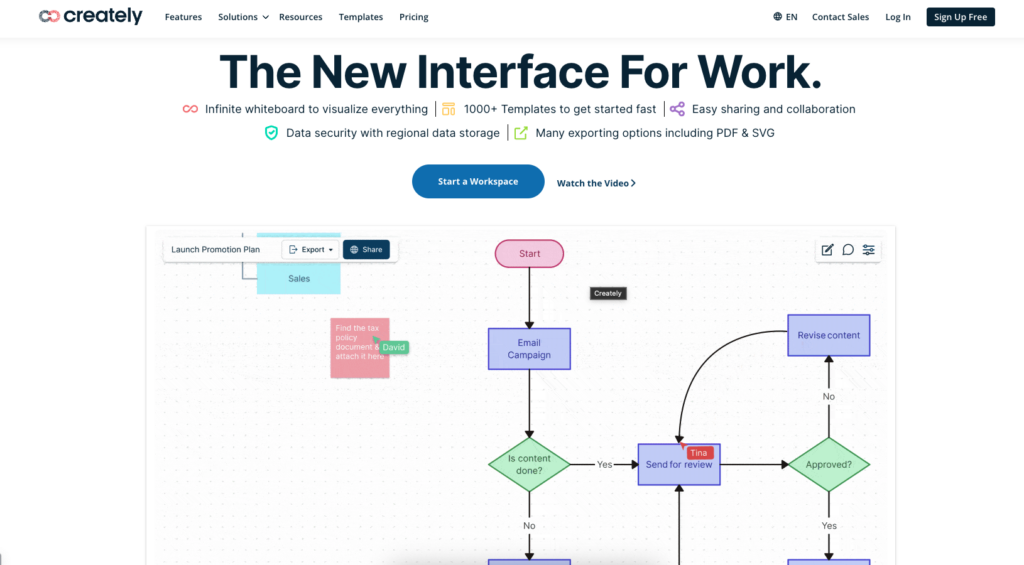
Creately offers a versatile platform for visual workspaces, making it an excellent choice for relationship mapping among various other uses. This tool provides an array of features designed to enhance collaboration and data visualization, ensuring that teams can work together effectively and efficiently.
- Templates: Creately is a business relationship mapping tool that offers a vast selection of templates for diagrams, charts, and maps, allowing users to quickly create professional and comprehensive visualizations.
- Real-Time Collaboration: Creately enables secure real-time collaboration, allowing team members to work together on relationship maps and other visual projects, regardless of their location.
- Integration: Creately integrates with various tools and platforms, providing a comprehensive data visualization solution. This integration ensures that all relevant information is easily accessible and can be incorporated into visual workspaces.ne is aligned and can contribute their insights and expertise to the project.
7. Visio
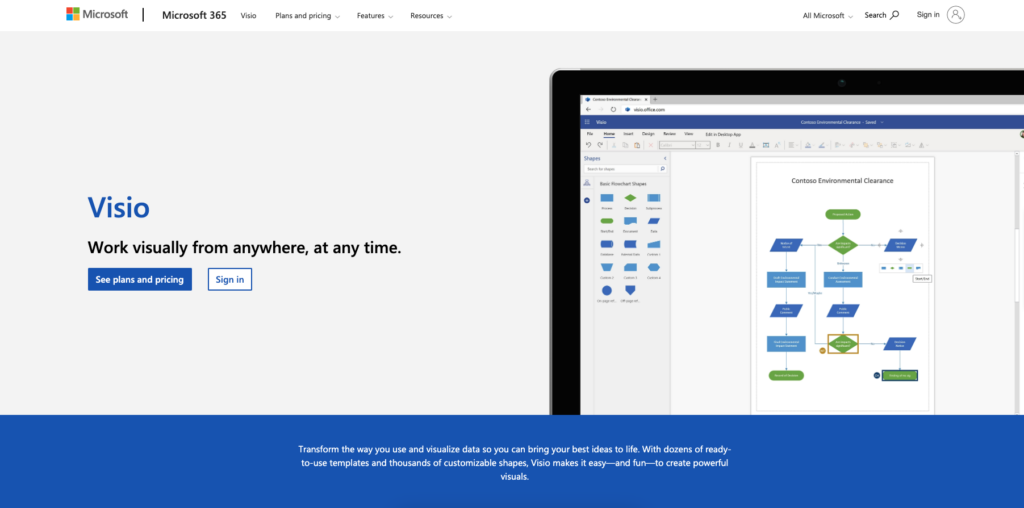
Microsoft Visio is a well-known and trusted tool in the data visualization space, and it is included in Microsoft 365 subscriptions. This tool offers a range of features that make it a powerful option for creating detailed and professional diagrams.
- Templates and Stencils: Visio provides dozens of templates and stencils for various types of diagrams, making it easy to start new projects and ensure consistency.
- Integration: Visio integrates seamlessly with Microsoft Teams and other Office apps, facilitating smooth workflows and collaboration within the Microsoft ecosystem.
- Data Visualizer Tool: The Data Visualizer tool allows users to quickly convert Excel data into Visio diagrams, streamlining the process of creating visual representations of data.
What Should You Look for in Relationship Mapping Software?
When choosing relationship mapping tools, consider the following features:
- Data Visualization The tool should offer robust data visualization capabilities to transform complex relationships into clear, understandable graphics. Look for software that can generate organizational charts and other visual representations quickly and accurately.
- Integrations A good relationship mapping tool should integrate with various data sources, including CRM platforms like Salesforce, email systems, phone logs, and social media. This ensures that all relevant data is included in your maps.
- Real-Time Updates Choose software that updates maps based on real-time data. This saves you the hassle of manually updating maps and ensures you always have the latest information.
- Templates Templates can save time and provide a starting point for your relationship maps. Look for tools that offer customizable templates for different use cases.
- Collaboration Team collaboration is crucial. Ensure the tool allows team members to share maps, add comments, and work together seamlessly. Cloud-based solutions are particularly effective for this.
- Process Improvement The best relationship mapping tools don’t just create maps; they also offer insights and suggestions for improving your processes. Look for software that helps you identify gaps and optimize your strategy.
- Usability Finally, consider the usability of the tool. It should be intuitive and easy to use, even for team members who may not be tech-savvy. A good user interface can make a big difference in how effectively the tool is adopted by your team.
Conclusion
Relationship mapping tools are essential for understanding and navigating the complex web of interactions within an organization. Whether you’re in sales, project management, or customer support, these tools can help you identify key decision-makers, streamline your processes, and ultimately achieve your goals more effectively.
From comprehensive solutions like DemandFarm and ClickUp to more specialized tools like Prolifiq and Upland Altify, there’s a wide range of options available to suit different needs and budgets. Consider the features that are most important to you and choose a tool that integrates seamlessly with your existing workflows.
 On-Demand Webinar: Unfiltered take on AI in Account Planning: Meet DemandFarm’s KAM AI
On-Demand Webinar: Unfiltered take on AI in Account Planning: Meet DemandFarm’s KAM AI 